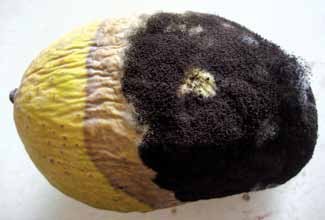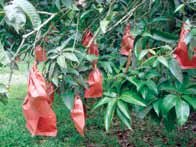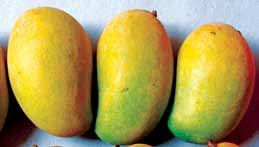mango fruit diseases management to reduce postharvest rotting
out of the total harvest, almost 15-20% of the fruits spoil. Fungi are the most common cause of mango fruit decay after harvest. it can be decreased by employing effective pre- and post-harvest practices in the production, harvesting, and post- harvest handling processes. the purpose of this article is to make end users aware of their obligations to reduce losses and the implications of such losses.
MANGOES are grown in a variety of climate across India. The quality of produce is determined by climatic and weather conditions. Mango varieties are grown in various climate zones and have varying shelf lives. The sensitivity of mango cultivars’ fruits to different pathogenic fungus varies as well. During the early stages of growth, mango fruits are relatively resistant to infection; but, as the fruits mature, their vulnerability to infection rises, and they become very sensitive during the period between harvest and consumption due to biochemical changes. Fruit rotting is caused by both saprophytic and pathogenic fungi. Depending on the factors affecting and practices followed, postharvest losses might range from 0 to 80%. The well-known major diseases are presented in order to provide a better understanding of how to protect mango fruits from losses.
Anthracnose
It is the most serious postharvest disease in the world, especially in areas where there are frequent rains during the development and maturity of the fruit. Anthracnose is caused by the fungus Colletotrichum gloeosporioides, which infects every tender part of the mango tree, including developing and mature fruits. Because the fungus is active all year in orchards, fruits on trees can be infected at any time if the weather conditions are favourable, such as optimum temperature (20-30°C), high relative humidity, prolonged rainfall, or heavy dew. The number and amount of rains are directly proportional to disease incidence and severity. Conidial germination, which is the primary and secondary inoculum source of infection, requires free water on the fruit surface as well as high humidity for more than 10 hours. However, if the storage temperature rises to 40°C during ripening, severe rotting is more likely. Initially, the infection is contained in the epicarp, but it spreads to the pulp in a short period of time. During the ripening of fruits, the disease appears as dark lesions on the harvested fruits. In severe cases, the disease progresses quickly and the entire fruit rots within a few days. The greatest cause of concern is rotting of mature fruits during postharvest handling, ripening, and transportation, which reduces the number of consumable fruits and results in significant losses. The pre-harvest care is directly linked to post-harvest rot when fruits are symptomless and a quiescent infection occurs during fruit development, but decay and rotting occurs after harvest during ripening.


Stem-end rot
The next most economically important postharvest disease of mango fruits is stem-end rot. Several fungi have been found to cause stem-end rot in mango fruits, including Lasiodiplodia theobromae, Aspergillus niger, Phomopsis mangiferae or Dithiorella dominicana, and Colletotrichum gloeosporioides. L. theobromae has been
identified as the most important secondary pathogen among these. The fungi that cause stem-end rot can also be found in soil and fallen leaves, from which the fruit can become infected after harvest. The pathogen is thought to enter mango trees through natural openings or wounds, then cause latent infection in the fruit by entering through the stem ends. Under high humidity, the conidia dispersed and released with free water. The pathogen can survive the winter on a tree or in the soil.
The disease is more common in orchards with older trees, in areas with a lot of rain, and when fruits are stored for a long time. The fungi remain latently infected within the branches and twigs. The endophytic hyphae colonizes the inflorescence and
extends to the stem end several weeks after flowering, but not into the fruit until harvest. In unripe fruit, the pathogen remains dormant. As the ripening process progresses, the fruit begins to rot near the stem end, turning brown-grey, soft, and rotting the entire fruit surface. When healthy fruits come into physical contact with decaying fruits, they become infected as well. Depending on the cause, the symptoms may differ.
- mangiferae causes firmer, more defined lesions that spread more
slowly than those caused by other stem-end rot fungi.

Bacterial black spot (canker)
The black spots are caused due to bacterial infection that causes cankers on fruits. In general, Xanthomonas campestris pv. mangiferae indicae infection is not considered a significant postharvest disease of mango fruits; however, when exposed to high humidity during storage, severely infected fruits may rot. The disease starts out as light- coloured water-soaked spots that progress to dark star- shaped cankers. Oozing of gummy substance from cracks caused by infection confirms bacterial infection. Other saprophytic fungi can grow in the tissue that has been damaged by bacterial infection.
Rot (Black)
Several species of the fungus Aspergillus cause black rot (A. niger, A. variecolor, A. nidulans, A. fumigatus, A. flavus, A. chevalieri). Fungus enters the fruits through wounds or cut ends after harvest, and infection begins as pale brown soft sunken spots that later coalesce into dark brown to black lesions that spread quickly. Later on, these lesions develop a lot of fungal growth. At 30-36°C, the disease progresses more quickly.
Other types of fruit rot
Mango fruit rotting is common after harvest due to the fungi mentioned above, but rotting can also be caused by infection or infestation by a variety of other fungi (Botryosphaeria ribis, Ceratocystis paradoxa, Pestalotiopsis versicolor, Macrophomina phaseolina, M. mangiferae, Alternaria tenuissima, Phoma mangiferae, Rhizopus arrhizus, Cladosporium herbarum, Cladosporium cladosporioides, Fusarium oxysporum and Rhizoctonia solani).

Factors influencing the onset of postharvest disease
Fruit yield and quality are influenced by a variety of factors, but good horticultural practices and timely application can help greatly.
Elements of the weather
Inoculum buildup, disease development, and ultimately, the extent of losses are all influenced by the weather and environment within the canopy. Canopy that allows free flow of air and light penetration creates a microclimate that is resistant to the majority of diseases. In orchards, rain facilitates pathogen invasion and the development of inoculums. During the monsoon season, the temperature drops to the ideal level for fungi to infect mature fruits. It remains dormant until the ripening process begins, at which point it causes severe rotting.

Cultural practices
Each and every activity which contributes towards minimizing incidence of diseases and promoting plant growth is important. Ploughing, weed management, pruning of infected twigs, and removal of fallen leaves, twigs, and fruits can all help to reduce pathogen inoculum build-up.
Pest management
In orchards where integrated pest management practices are used throughout the year, harvested fruits are safe. Sooty moulds are less likely to develop when sucking pests are controlled, resulting in reduced incidence of shoulder browning and sooty blotch.
Harvesting method, stage and postharvest handling Fruits should be harvested when they are fully mature and without injury; otherwise, infection/infestation and rotting are more likely. Picking fruits with a 2 cm stalk portion by hand with secateurs, keeping them gently in plastic crates, de-sapping, hot water treatment, cooling, drying, and packing into CF Boxes may be the
best option.
Postharvest disease management
Postharvest management includes the treatment of fruits after they have been harvested in order to extend their disease-free shelf life and maintain their appearance. Harvesting, de-sapping, grading, packaging, storage, and transportation, etc. all require caution. Huge losses are caused by the majority of mango growers’ lack of seriousness. Farmers must recognize the importance of postharvest handling and understand that their responsibility does not end till the fruit reaches the consumer. The following measures can be used to manage a variety of postharvest diseases.
- New orchards should not be planted in areas that receive a lot of rain during the fruiting season.
- Taking care of each new flush and orchard sanitation can help reduce anthracnose fungus inoculum build-up within the canopy.
- Pruning and orchard sanitation can reduce latent infection of the stem end rot pathogen in branches and twigs.
- It has been discovered that covering fruits with paper bags is effective.
- Fungicide pre-harvest sprays (difenoconazole 25EC @ 0.05%, propineb 70WP @ 0.2%, thiophanate methyl 70WP @ 0.1%, azoxystrobin 23SC @ 0.1%) performed 21-30 days before harvest resulted in excellent disease control.
- Bacillus licheniformis, Bacillus pumilus, and Bacillus subtilis have been found to be effective against anthracnose when applied to fruits after harvest.
- Hot water treatment of fruits has proven to be a safe method of controlling all pathogens that cause postharvest rots. The recommended temperature of water and time for dipping fruits has varied, but treatment at 52±1oC for 10 minutes has been found to be the most convenient and effective.
- Castor oil, eucalyptus oil, lemongrass oil, and garlic bulb, Azadirachta indica, Zingiber officinale, Lantana, and Curcuma longa extracts have all been found to be effective against anthracnose.



Author
P K Shukla

